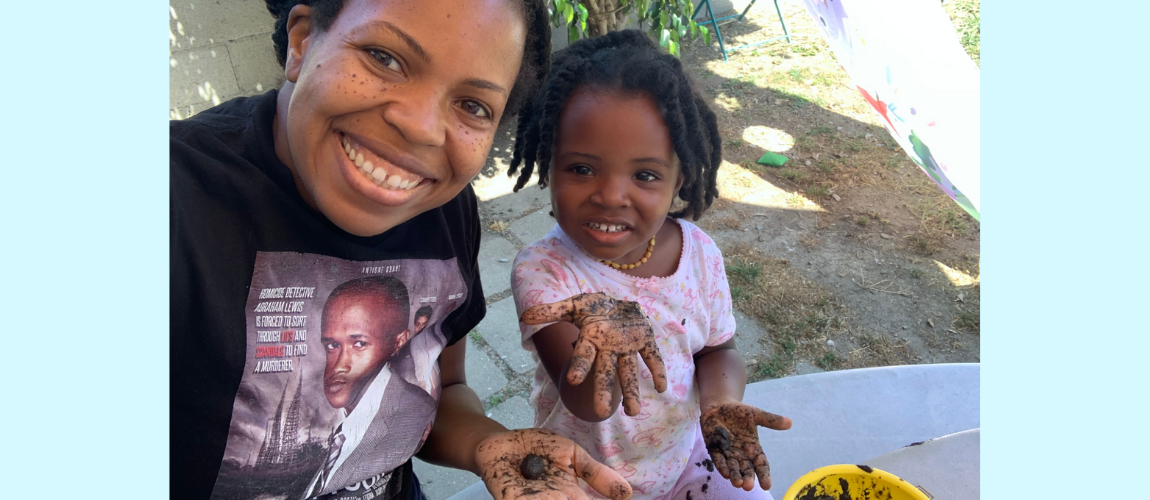We get it. Messy mud play is not always a grownup's dream. No matter how you and your kids feel about mud, you can still get all the goodness. It's just a matter of finding out your way to do mud play.
To start, it helps to remember the why—mud play activates multiple senses which boosts young brains. Messy play also lays the foundation for free, creative thinking. Mud can even help kids develop a healthy immune system.
Watch our Just Between Us Grown Ups: Messy Play video below for our tips to get the most out of mud play and how to make it work for everyone. For more short videos made to make you smile, laugh and maybe learn a little, too, visit our Just Between Us Grown Ups page!
How to make mud manageable for us
If mud works for you anywhere, anytime, that’s great! But it’s also unlikely. It’s OK if there’s a time and place for mud, and when we let kids go wild with some parameters, they’re still getting all the goodness!
First, designate certain days and times for mud play. This allows us the space to prepare for play and make sure we’re equipped for the cleanup that follows. This is also a wonderful lesson for kids to learn about boundaries and understand that messy play needs to work for both of us. Kids feel understood and empowered, but we also help them to learn that there are limits.
Second, pick a location that works for you. Take mud play outside, in the bathtub, or set up a mud kitchen! Picking a specific location is great for those of us who crave cleanliness and want the flexibility for quick cleanup without sacrificing all of the fun and learning benefits messy play brings.
Clothes and cleanup matter too
If you are able to dress kids in old or dark clothing that can take some dirt, that helps lower the stakes. If you have a classroom full of kids to support, you can ask families to send kids in dressed for mud play or welcome donations for big-kid or adult-sized shirts that can act as "smocks." Free-cycle and buy nothing groups can also be marvelous places to accumulate old clothes that make superb smocks for mud play!
How to make mud manageable for kids
But what if your kid is just not that into mud play?
For many children, experimenting with mud immediately brings joy and curiosity, while others need to take it slow. Every child (and adult) has a unique sensory system, and mud can push some kids too far out of their comfort zone. We call these mud mindsets and each can be supported in their own way! You may find your child’s mud mindset changes day by day, so it’s important to get a sense of how your child feels about messy play before we dive in.
To gauge where a child is at today, try these tips:
- Show kids how to rub their hands together to activate their sense of touch and prepare them for mud play.
- Model a little mud play yourself, and let kids decide if they want to try it out.
- Provide tools like sticks or leaves to make mud more manageable.
- Substitute mud with materials like forest putty, shaving cream or even water offer similar benefits with more control and less mess.
The key here is finding YOUR way to build in unstructured, child-led messy play. It nourishes imagination, creativity and independence.
Try one of our favorite mud activities
Ready to dive into mud play? We’ve compiled a list of our favorite messy DIY activities that help boost all of the important skills we love like imagination, fine motor, sensory, and creativity!
- Make Mud. Just have fun making mud and exploring various recipes for mud (including printable mud recipe cards)!
- Make mud art. In this activity, kids explore the many possibilities for mud play by transforming dirt and water into paint. And once made, the creative uses for mud paint are endless!
- Pigs in the mud. With just a few simple materials, kids can turn ordinary stones into pig friends and help their pigs (and themselves) stay cool as they play.
- Cooking in the mud kitchen. All you need is a few kitchen utensils, some dirt and water and voila! You’ll set the stage for hours of independent play as your child whips up their own mud recipes.
- Mud families. Kids use mud and objects from nature to create faces that represent their own unique family.

